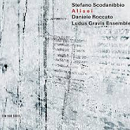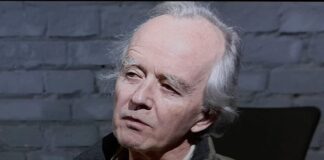Alisei & Stefano Scodanibbio’s Poetics of the Double Bass
1
In a recent piece I suggested that the contemporary equivalent or near-equivalent of the old Common Practice of functional harmony just might be found in the use of extended instrumental techniques, which have become pervasive in much new music both composed and improvised. The expansion of what it is possible to do on orchestral instrument has had a decisive influence not only on performance, as would be expected, but also on the universe of possibilities open to a composer. The double bassist Stefano Scodanibbio (1956-2012) was both a consummate performer and a challenging composer; his music represents an important contribution to this newer common practice.
Extended technique for Scodanibbio was more than a method or even a methodology. It was instead something akin to what painter Robert Motherwell called an original creative principle: a fundamental orientation or way of situating oneself vis-à-vis one’s materials and creative environment, a ground from which those materials and that environment could be grasped as concrete, creative possibilities and projected forward into specific works to be realized as one’s own. For Scodanibbio, the development and extension of the technical resources available to the double bass was his way of situating himself within the larger field of instrumental music.Within this larger field, Scodanibbio didn’t simply collect and collate the technical possibilities open to his instrument; like an uncanny explorer who calls a territory into being through the very act of mapping it, he was able to bring to fruition sounds and gestures lying latent in the double bass. They may have always already been there waiting to be discovered and coaxed out, but someone had to do the discovering and coaxing.
Of a piece with his technical innovations was Scodinabbio’s construction of a poetics. This definition and contextualization of procedure served to explicate, in sound if not in words, the place his technical methods had within his practice and the place his practice had within the field of performance and composition. Scodanibbio’s poetics, embodied in many of the works he wrote for double bass and other strings, put the making of the work at the center of its meaning, but—and this is an important qualification—method didn’t exhaust the meaning of the work. There was an artistry to his practice that prevented his music from being a mere exercise in what could be done. The exquisite technique, the carefully formulated vocabulary, the fortuitous ways he linked together gestures and sounds—all of this was done with affective force. Even so, his work pushed to the foreground the technical advances made for the instrument and engaged, at least implicitly, in a historical and historicizing dialogue with the progress of double bass technique in the modern period that began, roughly, in the 1960s and was honed to a fine edge in Italy by Fernando Grillo, one of Scodanibbio’s teachers.
A good example of Scodanibbio’s poetics at work is his refiguration for double bass of Luciano Berio’s Sequenza XIV for cello, which Scodanibbio undertook at Berio’s request. Berio asked Scodanibbio to “reinvent” the Sequenza in the bassist’s own language and that he did; the resulting Sequenza XIVb retains a family resemblance to its model but is unmistakably Scodanibbio’s, featuring as it does some of his characteristic techniques such as the seamless alteration of harmonics and ordinary tones, the rapid flamenco-like harp pizzicato, and chords constructed of overtones. Beneath its—admittedly stunning—surface, Sequenza XIVb stands as a fully-formulated poetics: a reflection on materials, methods and their possibilities through which these elements are raised to a kind of self-awareness and are enabled to speak their own musical truths.
2

Like Scodanibbio, Daniele Roccato is fluent in the language of contemporary double bass technique. Roccato, who is also an accomplished interpreter of the classical repertoire and anarranger of the Bach cello suites for double bass, is professor of double bass at the Conservatory “Santa Cecilia” in Rome. He has also worked with composers and improvisers as diverse as Gavin Bryars, Sofia Gubaidulina, Terry Riley, Butch Morris, Barre Phillips and Mark Dresser, among many others. He met Scodanibbio in 2008 at a festival in Paris and became a friend and collaborator; with Scodanibbio, he put together the double bass ensemble Ludus Gravis following a double bass festival Roccato organized in Perugia in 2009. Not long after they met, Roccato began integrating Scodanibbio’s compositions into his own concert repertoire. Alisei presents Roccato’s performances of four of these compositions, two for solo double bass, one for double bass octet, and one for two double basses. All are performed with a sensitivity and élan that put technique at the service of artistic finesse.
Like many of Scodanibbio’s works, Alisei, composed in 1986, is an essay in auto-counterpoint. A hammer-on left hand sets down a foundation of deep tones and a slow, simultaneous melodic overlay of harmonics; both layers ride on a gently rocking wave of explicit and implicit chordal movement. The diptych Due pezzi brillanti (1985), another solo work, is one of the first of Scodanibbio’s that Roccato began exploring. As with Alisei, it is a work built around sound strata in sharply different registers, again divided between harmonics and ordinary tones.
The duet Da una certa nebbia (2002), bearing the wryly Feldmanesque subtitle “for double bass and another double bass,” further develops the layered timbral counterpoint of the earlier pieces. It does this through an effective division of voices: a first bass playing an arco part mostly made up of surging and diminishing harmonics, and a “veiling” second bass providing a sparse scattering of plucked notes. It’s a beautiful, meditatively-paced piece that opposes the slow, bowed crescendi of the first bass with the brusque pizzicato interventions of the second bass. On the sharply outlined winter landscape that is this evocative performance Roccato is joined by Giacomo Piermatti.
The centerpiece of the recording is Otteto for eight double basses, in a tour de force performance by Ludus Gravis. Ottetowas composed in 2010-2011 and represents a kind of synopsis of Scodanibbio’s work for and with the double bass. Its late date and the circumstances of its composition give it a valedictory air, but one in a celebratory, rather than an elegiac, key. Although the piece is very much Scodanibbio’s self-portrait as an instrumentalist, it was written with the substantial collaboration of Roccato, who helped map out the basic contours and began to develop its realization with Ludus Gravis. The work, which is represented here in its premiere recording, was first performed live in its entirety in October 2012, only a few months after Scodanibbio’s death from ALS in January.
The thirty-minute-long work is nothing less than an encyclopedic presentation of Scodanibbio’s poetics, a synthesis and summary of his distinctive voice. All of his signature sounds are here, amplified and multiplied when fitted over an eight piece ensemble and traversing a substantial part of what the instrument is currently capable of. Otteto is a profoundly textural work woven of a rich repertoire of gestures—natural and artificial harmonics, spiccato and pressure bowing, flageolet and ordinary pizzicato, glissandi and many others–played individually or in pairs and threes, phased or in unison. The timbral variety of the piece is such that the homogeneity of the ensemble is belied in a kaleidoscope of sound color. Its effectiveness as a work depends on a high degree of precision and coordination, which Ludis Gravis, with the aid of conductor Tonino Battista, amply supplies.
3
The music on Alisei stands as a representative statement of the plastic values undergirding Scodanibbio’s artistry. In their essentials, these values are embodied in Scodanibbio’s construction of timbral counterpoint based on contrasts of weight and density. The basic plastic relationship at work consists of Scodanibbio’s innovative layering of harmonics and ordinary tones to create a tension of simultaneously sounding timbres of strikingly different qualities. In part, this was a function of Scodanibbio’s comprehensive exploration of the double bass’s capacity to produce harmonics at various locations: He routinely drew harmonics from across the geography of the fingerboard. Harmonics drawn from different locations on the string tend to have their own differences in sound quality, differences he was able to exploit for the greatest formal interest and fullest artistic effect.
At the heart of this effect is the expressive contrast between the wispy, ephemeral presence of the harmonics and the fuller-bodied stolidity of the ordinary tones. Compared to the latter, the former have a certain inexactness or inconsistency built into them; unlike ordinary tones, which are stopped at a precise point on the string, harmonics have well-defined sonic centers that shade off into more tenuous-sounding edges; they are highly sensitive to slight variations in the placement of the finger on the string as well as to nuances in bow or finger weight, angle of attack, and so on. This introduces an element of chance into the sound aggregates of harmonic-ordinary tone combinations; the sound quality of the harmonic is at least potentially variable, and this variability colors the way we hear not only the aggregated sound, but the ordinary tone as well. The result isn’t just a simple contrast between harmonic and ordinary tone, but a spread of differences ranged across a spectrum of subtle tinctures. The difference in presence and timbre between the ordinary tone and the harmonic can be the difference between closeness and distance, robust and brittle, the sturdy body and the shadow. Scodanibbio’s artistry, so well realized by Roccato and Ludus Gravis, turns out to be an artistryat once of solid marble and porous mist: one might say, of the emergence of music “da una certa nebbia.”







